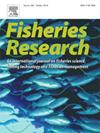Economic interdependencies and sectoral impacts: An input-output analysis of the Norwegian fisheries and aquaculture sector amidst COVID-19
IF 2.2
2区 农林科学
Q2 FISHERIES
引用次数: 0
Abstract
This study investigates the economic interdependencies and changes in the economic structure of the Norwegian fisheries and aquaculture sector during the COVID-19 pandemic through input-output analysis. Utilizing data from 2019 to 2021, I characterize the inter-industry structure of the sector relative to the Norwegian economy by using a Leontief, Ghosh models and the hypothetical extraction method that allow to calculate measures of inter-industry linkages. It is found that fisheries and aquaculture is key for the Norwegian economy as it has strong Hirschman-Rasmussen Indexes (HRI) for backward and forward linkages. Additionally, the sector has a relatively low dependence on imported inputs, and the structure of such imports did not change significantly between 2019 and 2021. A deeper analysis of the fisheries and aquaculture backward and forward linkages, reveals that the sector is highly connected to the food products, beverages, and tobacco industries, with stable dependency levels even amid the pandemic. The findings indicate that the fisheries and aquaculture sector maintained a stable industry structure despite COVID-19, partly due to its ability to adapt to changing global supply chain dynamics and domestic support measures. This research provides insights that may be helpful for policymakers aiming to enhance sectoral resilience and develop targeted economic recovery strategies in the face of future crises.
求助全文
约1分钟内获得全文
求助全文
来源期刊

Fisheries Research
农林科学-渔业
CiteScore
4.50
自引率
16.70%
发文量
294
审稿时长
15 weeks
期刊介绍:
This journal provides an international forum for the publication of papers in the areas of fisheries science, fishing technology, fisheries management and relevant socio-economics. The scope covers fisheries in salt, brackish and freshwater systems, and all aspects of associated ecology, environmental aspects of fisheries, and economics. Both theoretical and practical papers are acceptable, including laboratory and field experimental studies relevant to fisheries. Papers on the conservation of exploitable living resources are welcome. Review and Viewpoint articles are also published. As the specified areas inevitably impinge on and interrelate with each other, the approach of the journal is multidisciplinary, and authors are encouraged to emphasise the relevance of their own work to that of other disciplines. The journal is intended for fisheries scientists, biological oceanographers, gear technologists, economists, managers, administrators, policy makers and legislators.
 求助内容:
求助内容: 应助结果提醒方式:
应助结果提醒方式:


